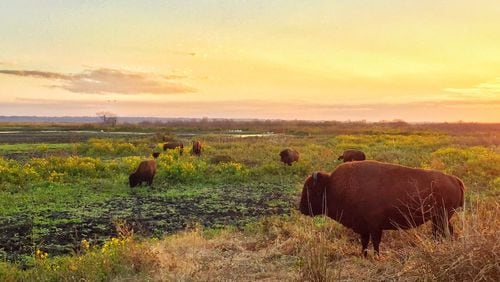Story by Stell Simonton.
When Lars Anderson was a boy in the late 1960s, his mother would drop him off in the morning at Paynes Prairie. He’d wander for hours, looking for snakes, turtles, alligators and other kinds of wildlife.
In the afternoon, his mother would pick him up, along with the small animals he’d collected.
Paynes Prairie Preserve is a free-range kind of place. Named after the Seminole leader King Payne, the 21,000-acre savanna is situated in the middle of north Florida. Bison roam, wild Florida cracker horses graze across the expanse, and alligators bask in the sun.
“It’s just this amazing place for wildlife,” says Anderson, who now runs Adventure Outfitters in High Springs, Fla., and leads wildlife and river tours in the state.
Paynes Prairie’s unique geographic features create a landscape that is one of the most significant natural and historic areas in Florida.
A good first stop for travelers is the Paynes Prairie Preserve Visitors Center, found just a few miles off I-75 and operated by Florida State Parks. I parked there on a warm day at noon and walked down a shady trail flanked by live oak, Spanish moss and thick, twining vines that give the path a fairytale quality.
“We’ve had to trim a lot of [the vines] back because we’re worried about the kids swinging on them,” says park ranger Dave Hartley.
Just inside the building entrance, a taxidermied eagle hangs from the high ceiling, its talons and wings outstretched. In the video screening room, low on the floor, stands a 10-foot stuffed alligator.
A view straight from the front glass door through the soaring window at the back frames the prairie beyond — including a single palm tree, tiny in the distance.
But the 50-foot observation tower provides the best views. I climbed wooden steps to a platform high in the canopy of live oaks and maples. A small breeze ruffled the leaves, insects buzzed in the silence, and egrets floated over the prairie.
I saw three bison grazing, flipping their tails against the flies. They lumbered along slowly, their heavy shoulders jutting forward.
“There were bison here in colonial times,” Hartley says, but they disappeared by the 1800s. In 1975, the park service reintroduced them from federal lands in Oklahoma, and the herd now numbers 53.
Paynes Prairie’s history includes the largest cattle ranch in Spanish-dominated Florida in the 1600s. It was named La Chua from a Potano Indian word for “jug,” which described the hole on the north side of the prairie where water drained from the land.
In the 1800s, Paynes Prairie was the home of Seminole Indians and saw much fighting during the Second Seminole War, one of the fiercest wars fought against Native Americans by the U.S. government.
While the observation tower is the best place to look for bison, visitors can also seek out wildlife from the 16 miles of trails, some of which are open to cyclists and horseback riders. Look for gopher tortoises along the 0.8-mile Lake Wauberg Trail or enjoy the 1,000-foot boardwalk and old cattle barn on the La Chua Trail. The ending of the latter is currently underwater due to heavy rainfall causing Lake Alachua to rise.
Underneath the lake is a natural drain hole known as the Alachua Sink.
“The sink is the heart and soul of the prairie,” Anderson says. “That’s what makes it so dynamic.”
Over thousands of years, rainwater dissolved the porous limestone found in this part of Florida, forming underground caverns. From time to time they collapsed, creating sinkholes, several of which together became the Alachua Sink.
In 1871, the sink inexplicably got plugged, and a lake formed in the prairie basin. Resorts were built along the shore, and steamboats ferried tourists across the lake. In 1891, the plug just as suddenly broke open, draining the lake within a week and stranding the steamboats and thousands of fish in the mud.
The sink’s natural fluctuation of water creates a diversity of habitats responsible for the variety of plant and animal life.
Visitors can bring canoes or kayaks to enjoy the lake, but no gasoline-powered boats are allowed.
Nearly 300 species of birds call Paynes Prairie home, making it a birdwatcher’s paradise. Northern Harrier hawks come down from Canada through Virginia to Florida along a route known as the Atlantic Flyway. Bobolinks come along this route to Florida and then head to South America.
Sandhill cranes come in the early winter, then mate and then go back north to nest. “We have a small population of sandhills all year,” Hartley says.
The campground is closed for renovation this fall but expected to re-open by January. Thirty-five RV and 15 tent-only sites are available in a shaded area around Lake Wauberg, with primitive camping available along the Chacala Trail, a 6.5-mile loop.
However, visitors can find hotel accommodations in nearby Gainesville or Micanopy.
The peak season for seeing wildlife starts in the fall and continues through March, with ranger talks and guided tours.
Paynes Prairie gives visitors the chance to envision the landscape as naturalist William Bartam described it in 1774: “The extensive Alachua Savanna is a level green plain. … Herds of sprightly deer, squadrons of the beautiful fleet Seminole horse, flocks of turkeys, civilized communities of the sonorous watchful crane, mixed together, appearing happy and contented in their enjoyment of peace, til disturbed and affrighted by the warrior of man.”
Paynes Prairie Preserve State Park. 100 Savannah Blvd., Micanopy, Fla. 352-466-3397. floridastateparks.org/park/Paynes-Prairie
Insider tips
Find antique shops and small-town atmosphere at nearby Micanopy. Drop by the Mosswood Farm Store bakery, get lunch at the Old Florida Café or stay in the historic Herlong Mansion, an antique-filled bed-and-breakfast. An estimated 30,000 people attend the Micanopy Fall Harvest Festival the last weekend in October.
Not far from Paynes Prairie, the homestead of “The Yearling” author Marjorie Kinnan Rawlings is at nearby Cross Creek and provides a glimpse of Old Florida and mid-20th century “cracker” culture. The Yearling Restaurant offers blues music, fried alligator and other delicacies.
About the Author






